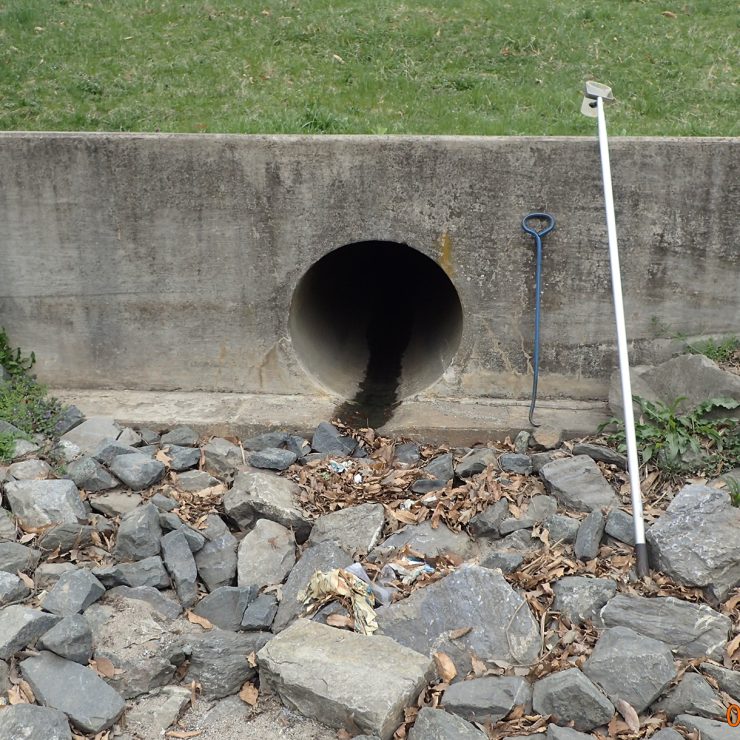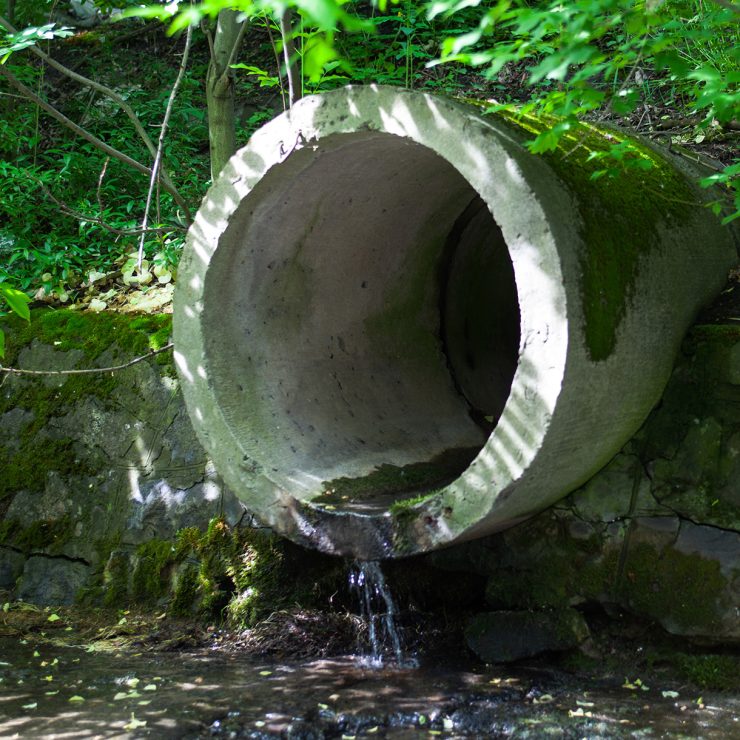By: Allie Daniere
Water pollution can originate from point sources, usually considered to be discharged from a pipe; or non-point sources, such as runoff, which are more difficult to eliminate as the sources are diffuse. As a means to reduce toxic loads from point sources into our waterways, The Clean Water Act (CWA) incorporates Illicit Discharge Detection and Elimination through Section 402 of the National Pollutant Discharge Elimination System (NPDES) Municipal Separate Storm Sewer System (MS4) permitting program.
The law requires municipalities and certain entities, both small (Phase II) and large (Phase I), to obtain programmatic permits, renewed every five years, in order to control legacy and pre-stormwater management (SWM) discharges to the maximum extent practicable (MEP). Phase I permits are granted to municipalities defined as “large” or “medium”, having populations greater than 100,000. Small municipalities and certain government entities (WMATA, MDOT SHA, WSSC) with less than 100,000 are authorized separately under Phase II NPDES stormwater rules, and must receive a Phase II General Permit (GP) to comply with Maryland’s receiving water quality standards.
Since no new construction is involved to obtain the permit, Phase II programmatic permits aim to implement the following six general minimum control measures (MCMs) to mitigate, offset, or remediate unmanaged and unregulated stormwater discharges in existing publicly owned stormwater systems and conveyances.
1. Personnel education and outreach
2. Public involvement and participation
3. Illicit discharge detection and elimination (IDDE)
4. Construction site stormwater runoff control
5. Post construction stormwater management
6. Pollution prevention and good housekeeping
The specific manner in which these are applied to the permittees are determined and monitored by the Maryland Department of the Environment (MDE), the delegated authority for the US Environmental Protection Agency (EPA), and varies depending on existing property conditions and the nature of the permittee’s activities. MCM 3 calls for an IDDE program to address point sources of pollution that can be detected at outfalls and locations where impervious runoff can be collected and assessed.
What’s the point of IDDE?
The goal of an IDDE program is to find and eliminate pollutants entering pre-existing storm drain system. 40 CFR 122.26(b)(2) defines an illicit discharge as any discharge to an MS4 that is not composed entirely of storm water, except allowable discharges pursuant to an NPDES permit.
Where to sample?
Under this MCM, municipalities must map out their storm drain systems, inspect the outfalls for polluted discharges, take steps to remove the illicit discharge if pollution is found, and annually report outcomes to the MDE. Once stormwater mapping is completed, illicit discharge screening locations must be identified and screened regularly for polluted discharges. Screening locations are usually selected to be the most downstream end of a stormwater pipeline within a municipality’s jurisdiction; whether it be an outfall or a manhole. For small properties (less than 100 acres), all outfalls should be screened yearly.
When and how to sample?
Illicit discharges can only be detected in dry weather, when the storm system pipes are not occupied by draining stormwater. The EPA defines a dry weather period as a “time interval during which less than 0.1 inch of rain is observed across a minimum of 72 hours.” Certain municipalities have lowered the dry-weather threshold to 48 hours to increase fieldwork possibility, but a good rule of thumb is to wait 72 hours before conducting IDDE inspections.
Data collected at each outfall is recorded on an “Outfall Reconnaissance Inventory/Sample Collection Field Sheet”, and a photo of each outfall is taken. Data collected for each screening location includes outfall material, shape, dimension and whether it is submerged in water or sediment. In the best-case and desired scenario, the outfall will not be flowing. In this instance, data collection consists of checking if the outfall has abnormalities like cracks, deposits, and other abnormal indicators.
A flowing outfall during dry weather should be further evaluated. First, the discharge must be checked for odor, color, turbidity, floatables, and flow rate. Next, the source of the outfall needs to be identified by tracking the flow up the stormwater pipe (pulling manhole covers) and inspecting inlets until the source is identified.
What are the different types of illicit discharge?
Different dry weather flow types may be found in storm drains. In some cases, a screening location may smell of sewage because sanitary sewer lines are leaking effluent further up the storm drain. There is a high likelihood of this screening location containing an illicit discharge. In other cases, a high groundwater table may be infiltrating the pipe at certain cracks and joints. Other types of dry weather flow include washwater, liquid wastes, tap water, and landscape irrigation. Whether or not the discharge is illicit depends on the severity of the physical indicators. Chemical testing may be necessary if the outfall is suspect of being illicit.
What to do if there is illicit flow?
If illicit flow is found, the jurisdiction must take counteractive actions to eliminate the polluted discharge and outcomes reported to MDE. Enforcement actions may be necessary in some cases.
How do IDDE requirements differ between Phase I and Phase II permits?
Rather than screening every single outfall, Phase I NPDES permits require municipalities to screen at least 100 outfalls annually throughout their jurisdictional area. The screening process for large/medium municipalities (Phase I) is similar to that of the small municipalities (Phase II) except that Phase I municipalities are also required to sample flowing outfalls using chemical test kits. These kits test for parameters including turbidity, pH, total chlorine, total copper, total phenol, and detergents (surfactants). Suspect samples that fall out of the allowed ranges for these parameters are sent to a laboratory for further chemical analysis. Outfalls that are suspected to contain illicit discharged are also revisited later during the monitoring period to determine if they are still emitting illicit material. In both Phase I and Phase II permits, all outfalls deemed to be suspect should be reported to MDE, and may require enforcement actions.
Explore the following resources for more information:
EPA. Appendix D: Outfall reconnaissance inventory/ sample collection field sheet, N.D.
https://www3.epa.gov/npdes/pubs/idde_appendix-d.pdf
Center for Watershed Protection and Dr. Robert Pitt. Illicit Discharge Detection and Elimination: A Guidance Manual for Program Development and Technical Assessments. MDE, 2004.
https://www3.epa.gov/npdes/pubs/idde_manualwithappendices.pdf
MDE. General permit for discharges from state and federal small municipal separate storm sewer systems. N.D.
MDE. National pollutant discharge elimination system municipal separate storm sewer system discharge permit. Howard County, Maryland. Effective December 18, 2014.

